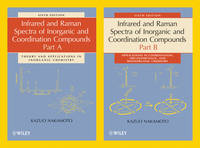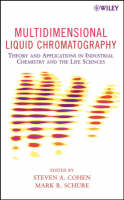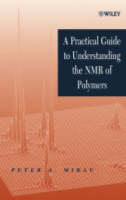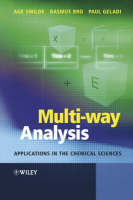Electron Paramagnetic Resonance
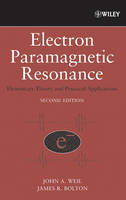 -15%
portes grátis
-15%
portes grátis
Electron Paramagnetic Resonance
Elementary Theory and Practical Applications
Weil, John A.; Bolton, James R.
John Wiley & Sons Inc
12/2006
688
Dura
Inglês
9780471754961
15 a 20 dias
1068
1 BASIC PRINCIPLES OF PARAMAGNETIC RESONANCE.
1.1 Introduction.
1.2 Historical Perspective.
1.3 A Simple EPR Spectrometer.
1.4 Scope of the EPR Technique.
1.5 Energy Flow in Paramagnetic Systems.
1.6 Quantization of Angular Momenta.
1.7 Relation Between Magnetic Moments and Angular Momenta.
1.8 Magnetic Field Quantities and Units.
1.9 Bulk Magnetic Properties.
1.10 Magnetic Energies and States.
1.11 Interaction of Magnetic Dipoles with Electromagnetic Radiation.
1.12 Characteristics of the Spin Systems.
1.13 Parallel-Field EPR.
1.14 Time-Resolved EPR.
1.15 Computerology.
1.16 EPR Imaging.
References.
Notes.
Further Reading.
Problems.
2 MAGNETIC INTERACTION BETWEEN PARTICLES.
2.1 Introduction.
2.2 Theoretical Considerations of the Hyperfine Interaction.
2.3 Angular-Momentum and Energy Operators.
2.4 Energy Levels of a System with One Unpaired Electron and One Nucleus with I = 1/2.
2.5 Energy Levels of a System with S = 1/2 and I = 1.
2.6 Signs of Isotropic Hyperfine Coupling Constants.
2.7 Dipolar Interactions Between Electrons.
References.
Notes.
Further Reading.
Problems.
3 ISOTROPIC HYPERFINE EFFECTS IN EPR SPECTRA.
3.1 Introduction.
3.2 Hyperfine Splitting from Protons.
3.3 Hyperfine Splittings from Other Nuclei with I = 1/2.
3.4 Hyperfine Splittings from Nuclei with I > 1/2.
3.5 Useful Rules for the Interpretation of EPR Spectra.
3.6 Higher-Order Contributions to Hyperfine Splittings.
3.7 Deviations from the Simple Multinomial Scheme.
3.8 Other Problems Encountered in EPR Spectra of Free Radicals.
3.9 Some Interesting p-Type Free Radicals.
References.
Notes.
Further Reading.
Problems.
4 ZEEMAN ENERGY (g) ANISOTROPY.
4.1 Introduction.
4.2 Systems with High Local Symmetry.
4.3 Systems with Rhombic Local Symmetry.
4.4 Construction of the g Matrix.
4.5 Symmetry-Related Sites.
4.6 EPR Line Intensities.
4.7 Statistically Randomly Oriented Solids.
4.8 Spin-Orbit Coupling and Quantum-Mechanical Modeling of g.
4.9 Comparative Overview.
References.
Notes.
Further Reading.
Problems.
5 HYPERFINE (A) ANISOTROPY.
5.1 Introduction.
5.2 Origin of the Anisotropic Part of the Hyperfine Interaction.
5.3 Determination and Interpretation of the Hyperfine Matrix.
5.4 Combined g and Hyperfine Anisotropy.
5.5 Multiple Hyperfine Matrices.
5.6 Systems With I > 1/2.
5.7 Hyperfine Powder Lineshapes.
References.
Notes.
Further Reading.
Problems.
6 SYSTEMS WITH MORE THAN ONE UNPAIRED ELECTRON.
6.1 Introduction.
6.2 Spin Hamiltonian for Two Interacting Electrons.
6.3 Systems with S = 1 (Triplet States).
6.4 Interacting Radical Pairs.
6.5 Biradicals.
6.6 Systems with S > 1.
6.7 High-Spin and High-Field Energy Terms.
6.8 The Spin Hamiltonian: A Summing up.
6.9 Modeling the Spin-Hamiltonian Parameters.
References.
Notes.
Further Reading.
Problems.
7 PARAMAGNETIC SPECIES IN THE GAS PHASE.
7.1 Introduction.
7.2 Monatomic Gas-Phase Species.
7.3 Diatomic Gas-Phase Species.
7.4 Triatomic and Polyatomic Gas-Phase Molecules.
7.5 Laser Electron Paramagnetic Resonance.
7.6 Other Techniques.
7.7 Reaction Kinetics.
7.8 Astro-EPR.
References.
Notes.
Further Reading.
Problems.
8 TRANSITION-GROUP IONS.
8.1 Introduction.
8.2 The Electronic Ground States of d-Electron Species.
8.3 The EPR Parameters of d-Electron Species.
8.4 Tanabe-Sugano Diagrams and Energy-Level Crossings.
8.5 Covalency Effects.
8.6 A Ferroelectric System.
8.7 Some f-Electron Systems.
References.
Notes.
Further Reading.
Problems.
9 THE INTERPRETATION OF EPR PARAMETERS.
9.1 Introduction.
9.2 ?-Type Organic Radicals.
9.3 ?-Type Organic Radicals.
9.4 Triplet States and Biradicals.
9.5 Inorganic Radicals.
9.6 Electrically Conducting Systems.
9.7 Techniques for Structural Estimates from EPR Data.
References.
Notes.
Further Reading.
Problems.
Appendix 9A Hu?ckel Molecular-Orbital Calculations.
HMO References.
HMO Problems.
10 RELAXATION TIMES, LINEWIDTHS AND SPIN KINETIC PHENOMENA.
10.1 Introduction.
10.2 Spin Relaxation: General Aspects.
10.3 Spin Relaxation: Bloch Model.
10.4 Linewidths.
10.5 Dynamic Lineshape Effects.
10.6 Longitudinal Detection.
10.7 Saturation-Transfer EPR.
10.8 Time Dependence of the EPR Signal Amplitude.
10.9 Dynamic Nuclear Polarization.
10.10 Bio-Oxygen.
10.11 Summary.
References.
Notes.
Further Reading.
Problems.
11 NONCONTINUOUS EXCITATION OF SPINS.
11.1 Introduction.
11.2 The Idealized B1 Switch-on.
11.3 The Single B1 Pulse.
11.4 Fourier-Transform EPR and FID Analysis.
11.5 Multiple Pulses.
11.6 Electron Spin-Echo Envelope Modulation.
11.7 Advanced Techniques.
11.8 Spin Coherence and Correlation.
References.
Notes.
Further Reading .
Problems.
12 DOUBLE-RESONANCE TECHNIQUES.
12.1 Introduction.
12.2 A Continuous-Wave ENDOR Experiment.
12.3 Energy Levels and ENDOR Transitions.
12.4 Relaxation Processes in Steady-State ENDOR5.
12.5 CW ENDOR: Single-Crystal Examples.
12.6 CW ENDOR in Powders and Non-Crystalline Solids.
12.7 CW ENDOR in Liquid Solutions.
12.8 Pulse Double-Resonance Experiments.
12.9 Electron-Electron Double Resonance (ELDOR).
12.10 Optically Detected Magnetic Resonance.
12.11 Fluorescence-Detected Magnetic Resonance.
References.
Notes.
Further Reading.
Problems.
13 OTHER TOPICS.
13.1 Apologia .
13.2 Biological Systems.
13.3 Clusters.
13.4 Charcoal, Coal, Graphite and Soot .
13.5 Colloids.
13.6 Electrochemical EPR.
13.7 EPR Imaging.
13.8 Ferromagnets, Antiferromagnets and Superparamagnets.
13.9 Glasses.
13.10 Geologic/Mineralogic Systems and Selected Gems.
13.11 Liquid Crystals.
3.12 "Point" Defects.
13.13 Polymers.
13.14 Radiation Dosage and Dating.
13.15 Spin Labels.
13.16 Spin Traps.
13.17 Trapped Atoms and Molecules.
APPENDIX A MATHEMATICAL OPERATIONS.
A.1 Complex Numbers.
A.2 Operator Algebra.
A.3 Determinants.
A.4 Vectors: Scalar, Vector, and Outer Products.
A.5 Matrices.
A.6 Perturbation Theory.
A.7 Dirac Delta Function.
A.8 Group Theory.
References.
Notes.
Further Reading.
Problems.
APPENDIX B QUANTUM MECHANICS OF ANGULAR MOMENTUM.
B.1 Introduction.
B.2 Angular-Momentum Operators.
B.3 Commutation Relations for General Angular-Momentum Operators.
B.4 Eigenvalues of J2 and Jz.
B.5 Superposition of States.
B.6 Angular-Momentum Matrices.
B.7 Addition of Angular Momenta.
B.8 Notation for Atomic and Molecular States.
B.9 Angular Momentum and Degeneracy of States.
B.10 Time Dependence.
B.11 Precession.
B.12 Magnetic Flux Quantization.
B.13 Summary.
References.
Notes.
Further Reading.
Problems.
Notes for Problem B.12.
APPENDIX C THE HYDROGEN ATOM AND SELECTED RADICALS RHn.
C.1 Hydrogen Atom.
C.2 RH Radicals.
C.3 RH2 Radicals.
References.
Notes.
Further Reading.
Problems.
APPENDIX D PHOTONS.
D.1 Introduction.
D.2 The Physical Aspects of Photons.
D.3 Magnetic-Resonance Aspects.
References.
Notes.
APPENDIX E INSTRUMENTATION AND TECHNICAL PERFORMANCE.
E.1 Instrumental: Background.
E.2 CW EPR Spectrometers.
E.3 Pulsed EPR Spectrometers.
E.4 Computer Interfacing with EPR Spectrometers.
E.5 Techniques for Temperature Variation and Control.
E.6 Techniques for Pressure Variation.
References.
Notes.
Further Reading.
Problems.
APPENDIX F EXPERIMENTAL CONSIDERATIONS.
F.1 Techniques for Generation of Paramagnetic Species.
F.2 Lineshapes and Intensities.
F.3 Sensitivity and Resolution.
F.4 Measurements.
References.
Notes.
Further Reading.
Problems.
APPENDIX G EPR-RELATED BOOKS AND SELECTED CHAPTERS.
APPENDIX H FUNDAMENTAL CONSTANTS, CONVERSION FACTORS, AND KEY DATA.
APPENDIX I MISCELLANEOUS GUIDELINES.
I.1 Notation for Symbols.
I.2 Glossary of Symbols.
I.3 Abbreviations.
I.4 Exponent Nomenclature.
I.5 Journal Reference Style.
Author Index.
Subject Index.
1 BASIC PRINCIPLES OF PARAMAGNETIC RESONANCE.
1.1 Introduction.
1.2 Historical Perspective.
1.3 A Simple EPR Spectrometer.
1.4 Scope of the EPR Technique.
1.5 Energy Flow in Paramagnetic Systems.
1.6 Quantization of Angular Momenta.
1.7 Relation Between Magnetic Moments and Angular Momenta.
1.8 Magnetic Field Quantities and Units.
1.9 Bulk Magnetic Properties.
1.10 Magnetic Energies and States.
1.11 Interaction of Magnetic Dipoles with Electromagnetic Radiation.
1.12 Characteristics of the Spin Systems.
1.13 Parallel-Field EPR.
1.14 Time-Resolved EPR.
1.15 Computerology.
1.16 EPR Imaging.
References.
Notes.
Further Reading.
Problems.
2 MAGNETIC INTERACTION BETWEEN PARTICLES.
2.1 Introduction.
2.2 Theoretical Considerations of the Hyperfine Interaction.
2.3 Angular-Momentum and Energy Operators.
2.4 Energy Levels of a System with One Unpaired Electron and One Nucleus with I = 1/2.
2.5 Energy Levels of a System with S = 1/2 and I = 1.
2.6 Signs of Isotropic Hyperfine Coupling Constants.
2.7 Dipolar Interactions Between Electrons.
References.
Notes.
Further Reading.
Problems.
3 ISOTROPIC HYPERFINE EFFECTS IN EPR SPECTRA.
3.1 Introduction.
3.2 Hyperfine Splitting from Protons.
3.3 Hyperfine Splittings from Other Nuclei with I = 1/2.
3.4 Hyperfine Splittings from Nuclei with I > 1/2.
3.5 Useful Rules for the Interpretation of EPR Spectra.
3.6 Higher-Order Contributions to Hyperfine Splittings.
3.7 Deviations from the Simple Multinomial Scheme.
3.8 Other Problems Encountered in EPR Spectra of Free Radicals.
3.9 Some Interesting p-Type Free Radicals.
References.
Notes.
Further Reading.
Problems.
4 ZEEMAN ENERGY (g) ANISOTROPY.
4.1 Introduction.
4.2 Systems with High Local Symmetry.
4.3 Systems with Rhombic Local Symmetry.
4.4 Construction of the g Matrix.
4.5 Symmetry-Related Sites.
4.6 EPR Line Intensities.
4.7 Statistically Randomly Oriented Solids.
4.8 Spin-Orbit Coupling and Quantum-Mechanical Modeling of g.
4.9 Comparative Overview.
References.
Notes.
Further Reading.
Problems.
5 HYPERFINE (A) ANISOTROPY.
5.1 Introduction.
5.2 Origin of the Anisotropic Part of the Hyperfine Interaction.
5.3 Determination and Interpretation of the Hyperfine Matrix.
5.4 Combined g and Hyperfine Anisotropy.
5.5 Multiple Hyperfine Matrices.
5.6 Systems With I > 1/2.
5.7 Hyperfine Powder Lineshapes.
References.
Notes.
Further Reading.
Problems.
6 SYSTEMS WITH MORE THAN ONE UNPAIRED ELECTRON.
6.1 Introduction.
6.2 Spin Hamiltonian for Two Interacting Electrons.
6.3 Systems with S = 1 (Triplet States).
6.4 Interacting Radical Pairs.
6.5 Biradicals.
6.6 Systems with S > 1.
6.7 High-Spin and High-Field Energy Terms.
6.8 The Spin Hamiltonian: A Summing up.
6.9 Modeling the Spin-Hamiltonian Parameters.
References.
Notes.
Further Reading.
Problems.
7 PARAMAGNETIC SPECIES IN THE GAS PHASE.
7.1 Introduction.
7.2 Monatomic Gas-Phase Species.
7.3 Diatomic Gas-Phase Species.
7.4 Triatomic and Polyatomic Gas-Phase Molecules.
7.5 Laser Electron Paramagnetic Resonance.
7.6 Other Techniques.
7.7 Reaction Kinetics.
7.8 Astro-EPR.
References.
Notes.
Further Reading.
Problems.
8 TRANSITION-GROUP IONS.
8.1 Introduction.
8.2 The Electronic Ground States of d-Electron Species.
8.3 The EPR Parameters of d-Electron Species.
8.4 Tanabe-Sugano Diagrams and Energy-Level Crossings.
8.5 Covalency Effects.
8.6 A Ferroelectric System.
8.7 Some f-Electron Systems.
References.
Notes.
Further Reading.
Problems.
9 THE INTERPRETATION OF EPR PARAMETERS.
9.1 Introduction.
9.2 ?-Type Organic Radicals.
9.3 ?-Type Organic Radicals.
9.4 Triplet States and Biradicals.
9.5 Inorganic Radicals.
9.6 Electrically Conducting Systems.
9.7 Techniques for Structural Estimates from EPR Data.
References.
Notes.
Further Reading.
Problems.
Appendix 9A Hu?ckel Molecular-Orbital Calculations.
HMO References.
HMO Problems.
10 RELAXATION TIMES, LINEWIDTHS AND SPIN KINETIC PHENOMENA.
10.1 Introduction.
10.2 Spin Relaxation: General Aspects.
10.3 Spin Relaxation: Bloch Model.
10.4 Linewidths.
10.5 Dynamic Lineshape Effects.
10.6 Longitudinal Detection.
10.7 Saturation-Transfer EPR.
10.8 Time Dependence of the EPR Signal Amplitude.
10.9 Dynamic Nuclear Polarization.
10.10 Bio-Oxygen.
10.11 Summary.
References.
Notes.
Further Reading.
Problems.
11 NONCONTINUOUS EXCITATION OF SPINS.
11.1 Introduction.
11.2 The Idealized B1 Switch-on.
11.3 The Single B1 Pulse.
11.4 Fourier-Transform EPR and FID Analysis.
11.5 Multiple Pulses.
11.6 Electron Spin-Echo Envelope Modulation.
11.7 Advanced Techniques.
11.8 Spin Coherence and Correlation.
References.
Notes.
Further Reading .
Problems.
12 DOUBLE-RESONANCE TECHNIQUES.
12.1 Introduction.
12.2 A Continuous-Wave ENDOR Experiment.
12.3 Energy Levels and ENDOR Transitions.
12.4 Relaxation Processes in Steady-State ENDOR5.
12.5 CW ENDOR: Single-Crystal Examples.
12.6 CW ENDOR in Powders and Non-Crystalline Solids.
12.7 CW ENDOR in Liquid Solutions.
12.8 Pulse Double-Resonance Experiments.
12.9 Electron-Electron Double Resonance (ELDOR).
12.10 Optically Detected Magnetic Resonance.
12.11 Fluorescence-Detected Magnetic Resonance.
References.
Notes.
Further Reading.
Problems.
13 OTHER TOPICS.
13.1 Apologia .
13.2 Biological Systems.
13.3 Clusters.
13.4 Charcoal, Coal, Graphite and Soot .
13.5 Colloids.
13.6 Electrochemical EPR.
13.7 EPR Imaging.
13.8 Ferromagnets, Antiferromagnets and Superparamagnets.
13.9 Glasses.
13.10 Geologic/Mineralogic Systems and Selected Gems.
13.11 Liquid Crystals.
3.12 "Point" Defects.
13.13 Polymers.
13.14 Radiation Dosage and Dating.
13.15 Spin Labels.
13.16 Spin Traps.
13.17 Trapped Atoms and Molecules.
APPENDIX A MATHEMATICAL OPERATIONS.
A.1 Complex Numbers.
A.2 Operator Algebra.
A.3 Determinants.
A.4 Vectors: Scalar, Vector, and Outer Products.
A.5 Matrices.
A.6 Perturbation Theory.
A.7 Dirac Delta Function.
A.8 Group Theory.
References.
Notes.
Further Reading.
Problems.
APPENDIX B QUANTUM MECHANICS OF ANGULAR MOMENTUM.
B.1 Introduction.
B.2 Angular-Momentum Operators.
B.3 Commutation Relations for General Angular-Momentum Operators.
B.4 Eigenvalues of J2 and Jz.
B.5 Superposition of States.
B.6 Angular-Momentum Matrices.
B.7 Addition of Angular Momenta.
B.8 Notation for Atomic and Molecular States.
B.9 Angular Momentum and Degeneracy of States.
B.10 Time Dependence.
B.11 Precession.
B.12 Magnetic Flux Quantization.
B.13 Summary.
References.
Notes.
Further Reading.
Problems.
Notes for Problem B.12.
APPENDIX C THE HYDROGEN ATOM AND SELECTED RADICALS RHn.
C.1 Hydrogen Atom.
C.2 RH Radicals.
C.3 RH2 Radicals.
References.
Notes.
Further Reading.
Problems.
APPENDIX D PHOTONS.
D.1 Introduction.
D.2 The Physical Aspects of Photons.
D.3 Magnetic-Resonance Aspects.
References.
Notes.
APPENDIX E INSTRUMENTATION AND TECHNICAL PERFORMANCE.
E.1 Instrumental: Background.
E.2 CW EPR Spectrometers.
E.3 Pulsed EPR Spectrometers.
E.4 Computer Interfacing with EPR Spectrometers.
E.5 Techniques for Temperature Variation and Control.
E.6 Techniques for Pressure Variation.
References.
Notes.
Further Reading.
Problems.
APPENDIX F EXPERIMENTAL CONSIDERATIONS.
F.1 Techniques for Generation of Paramagnetic Species.
F.2 Lineshapes and Intensities.
F.3 Sensitivity and Resolution.
F.4 Measurements.
References.
Notes.
Further Reading.
Problems.
APPENDIX G EPR-RELATED BOOKS AND SELECTED CHAPTERS.
APPENDIX H FUNDAMENTAL CONSTANTS, CONVERSION FACTORS, AND KEY DATA.
APPENDIX I MISCELLANEOUS GUIDELINES.
I.1 Notation for Symbols.
I.2 Glossary of Symbols.
I.3 Abbreviations.
I.4 Exponent Nomenclature.
I.5 Journal Reference Style.
Author Index.
Subject Index.






